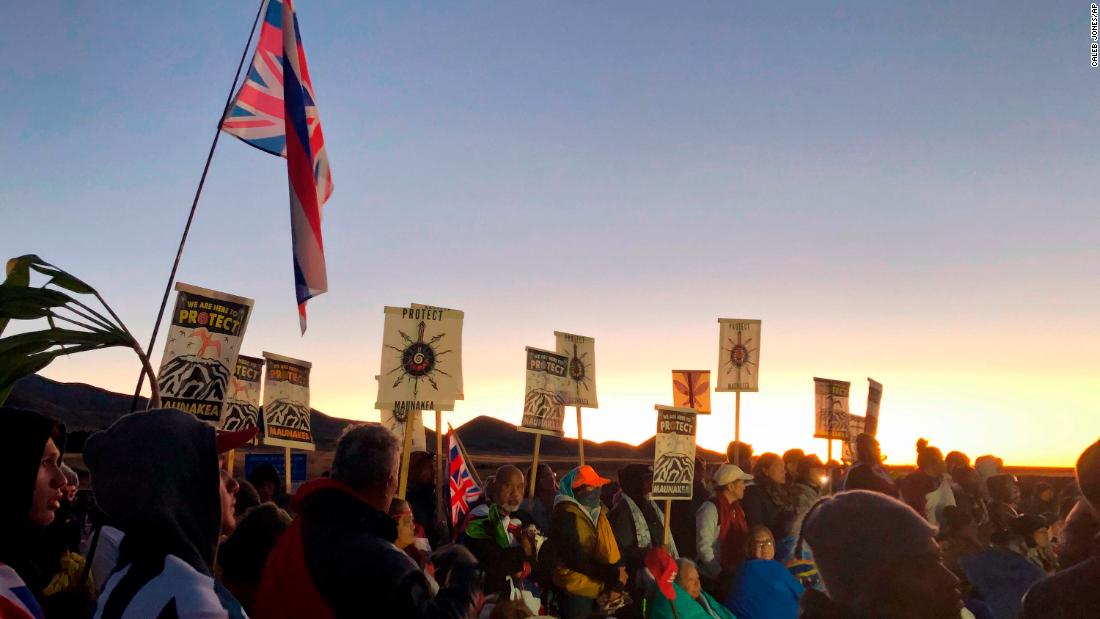[ad_1]
Kaho’okahi Kanuha, a leader of the group, told CNN on Sunday that organizers believe more than 2,000 people have assembled at the Mauna Kea access road, where they’ve built a makeshift camp and blockade in hopes of preventing construction from getting underway.
It’s a conflict years in the making. Scientists see Mauna Kea as a prime location for peering into the deep reaches of space. But for some native Hawaiians, the dormant volcano, the highest peak in Hawaii, is sacred ground.
The barren landscape is rich with their history, and is believed to be the site of the genesis of the Hawaiian people. Many of their revered ancestors are buried there.
“It is without a doubt one of our most sacred places in all of Hawaii,” Kanuha told CNN, saying it was home to sacred waters and native Hawaiian deities.
And so the protectors have gathered there, Kanuha told CNN.
He pointed out that the mauna, or mountain, has already been “desecrated” 13 times by other observatories, and “many of them have been the so-called last telescope,” he said. Now, enough is enough.
“We are taking a stand not only to protect our mauna and aina, our land, who we have a genealogical connection to,” Kanuha said. “We are fighting to protect it because we know if we cannot stop this, there is not very much we can fight for or protect.”
“This is our last stand,” he said.
The team behind Thirty Meter Telescope (TMT), did not immediately respond to a request for comment Sunday.
“We are deeply committed to integrating science and culture on Maunakea and in Hawai’i,” Yang said, “and to enriching educational opportunities and the local economy.”
Growing tension
Police on Wednesday arrested 33 protesters, per Dan Dennison, a spokesman for the Department of Land and Natural resources. They were elders in the community who had chosen to be arrested and formed a line to block the road.
They were released almost immediately, Dennison said. They were given the option to get a citation and leave the area.
The past several days have seen Hawaii’s governor and protesters at odds over the conditions at the camp.
Gov. Ige on Friday told reporters he would not call in additional troops from the National Guard and had never considered using tear gas to disperse the crowds. He said his “number one priority has been and continues to be the safety of all people.”
“However, there are thousands of people on the mountain, and I encourage all to remain respectful and calm,” he added.
Ige painted an image of a disorganized camp, where there were “inadequate bathroom and rubbish facilities” and reports of drug and alcohol use.
Port-a-potties were at the camp and were cleaned twice daily, trash was changed out several times a day, and there was even recycling, organizers told KHON.
“There are absolutely no signs of drugs or alcohol,” Honolulu City Councilwoman Heidi Tsuneyoshi told the station. “No one is even allowed to smoke here.”
Kanuha told CNN the governor’s press conference was full of “disinformation,” and said that Ige hadn’t laid eyes on the site himself.
“What we have here is not an image of dysfunction and not an image of a crumbling society,” he said. “We have images of, basically, people uniting, people coming together, and each and every day we get bigger and bigger and become more organized and get stronger and stronger.”
CNN’s Ryan Prior and Chris Boyette contributed to this report.
[ad_2]
Source link





